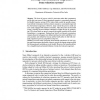Free Online Productivity Tools
i2Speak
i2Symbol
i2OCR
iTex2Img
iWeb2Print
iWeb2Shot
i2Type
iPdf2Split
iPdf2Merge
i2Bopomofo
i2Arabic
i2Style
i2Image
i2PDF
iLatex2Rtf
Sci2ools
CONCUR
2005
Springer
2005
Springer
Deriving Weak Bisimulation Congruences from Reduction Systems
The focus of process calculi is interaction rather than computation, and for this very reason: (i) their operational semantics is conveniently expressed by labelled transition systems (LTSs) whose labels model the possible interacth the environment; (ii) their abstract semantics is conveniently expressed by observational congruences. However, many current-day process calculi are more easily equipped with reduction semantics, where the notion of observable action is missing. Recent techniques attempted to bridge this gap by synthesising LTSs whose labels are process contexts that enable reactions and for which bisimulation is a congruence. Starting from Sewell’s set-theoretic construction, category-theoretic techniques were defined and based on Leifer and Milner’s relative pushouts, later refined by Sassone and the fourth author to deal with structural congruences given as groupoidal 2-categories. Building on recent works concerning observational equivalences for tile logic, the p...
Related Content
| Added | 26 Jun 2010 |
| Updated | 26 Jun 2010 |
| Type | Conference |
| Year | 2005 |
| Where | CONCUR |
| Authors | Roberto Bruni, Fabio Gadducci, Ugo Montanari, Pawel Sobocinski |
Comments (0)

